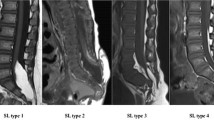Abstract
Purpose
The present study aims to identify clinical and pathological factors that can predict the risk of spinal cord anomalies (SCA) in patients with anorectal malformations (ARM), the need for neurosurgery, and to define the impact of SCA on the outcome of patients with ARM.
Methods
A 16-year retrospective analysis of all patients treated at a single tertiary children’s Hospital with diagnosis of ARM. Data were collected to assess the impact of defined clinical characteristics on prevalence of SCA (detected at MRI). Children surgically treated or not for SCA were compared for age, clinical symptoms and type of anomalies at surgery or at last follow-up, respectively. Moreover, patients with intermediate/high ARMs, with or without SCA were compared for neurogenic bladder (NB), constipation, soiling and need for bowel management (BM).
Results
Two hundred and seventy-five children were treated for ARM in the study period, 142 had spinal MRI that showed SCA in 85. Patients with SCA had significantly higher prevalence of preterm birth (p < 0.05), cardiac anomalies (p = 0.02), vertebral anomalies (p = 0.0075), abnormal sacrum (p < 0.0001), and VACTERL association (p = 0.0233). Ten patients were surgically treated for SCA. The prevalence of neurological bladder and neuro-motor deficits, of vertebral and genital anomalies, particularly cryptorchidism, was significantly higher in the operated group (p < 0.01, for each analysis). In patients with intermediate/high ARMs, no significant difference was observed between those with or without SCA, in terms of prevalence of NB, intestinal function and need for BM.
Conclusions
In patients with ARM, factors that can predict a higher prevalence of SCA and also determine an increased indication to neurosurgery may be identified. SCA by itself does not seem to affect the functional prognosis of children with intermediate/high ARM. These data may help physicians in stratifying the clinical and diagnostic pathway of patients with ARM.
Similar content being viewed by others
References
Levitt MA, Pena A (2010) Imperforate anus and cloacal malformations. In: Holcomb GW III, Murphy JP (eds) Ashcraft’s pediatric surgery, 5th edn. Saunders Elsevier, Philadelphia, pp 468–490
Stoll C, Alembik Y, Dott B et al (2007) Associated malformations in patients with anorectal anomalies. Eur J Med Genet 50:281–290
Hassink EA, Rieu PN, Hamel BC, Severijnen RS, vd Staak FH, Festen C (1996) Additional congenital defects in anorectal malformations. Eur J Pediatr 155(6):477–482
Rittler M, Paz JE, Castilla EE (1996) VACTERL association, epidemiologic definition and delineation. Am J Med Genet 63(4):529–536
van den Hondel D, Sloots C, de Jong TH, Lequin M, Wijnen R (2016) Screening and treatment of tethered spinal cord in anorectal malformation patients. Eur J Pediatr Surg (Z Kinderchir) 26(1):22–28
Golonka NR, Haga LJ, Keating RP, Eichelberger MR, Gilbert JC, Hartman GE et al (2002) Routine MRI evaluation of low imperforate anus reveals unexpected high incidence of tethered spinal cord. J Pediatr Surg 37(7):966–969
Uchida K, Inoue M, Matsubara T, Otake K, Koike Y, Okugawa Y et al (2007) Evaluation and treatment for spinal cord tethering in patients with anorectal malformations. Eur J Pediatr Surg (Z Kinderchir) 17(6):408–411
Tuuha SE, Aziz D, Drake J, Wales P, Kim PC (2004) Is surgery necessary for asymptomatic tethered cord in anorectal malformation patients? J Pediatr Surg 39(5):773–777
Scottoni F, Iacobelli BD, Zaccara AM, Totonelli G, Schingo AM, Bagolan P (2014) Spinal ultrasound in patients with anorectal malformations: is this the end of an era? Pediatr Surg Int 30(8):829–831
Holschneider A, Hutson J, Peña A, Beket E, Chatterjee S, Coran A, et al (2005) Preliminary report on the International Conference for the Development of Standards for the Treatment of Anorectal Malformations. J Pediatr Surg 40(10):1521–1526
Levitt MA, Patel M, Rodriguez G, Gaylin DS, Pena A (1997) The tethered spinal cord in patients with anorectal malformations. J Pediatr Surg 32(3):462–468
Mosiello G, Capitanucci ML, Gatti C, Adorisio O, Lucchetti MC, Silveri M et al (2003) How to investigate neurovesical dysfunction in children with anorectal malformations. J Urol 170(4 Pt 2):1610–1613
Borg H, Holmdahl G, Olsson I, Wiklund LM, Sillen U (2009) Impact of spinal cord malformation on bladder function in children with anorectal malformations. J Pediatr Surg 44(9):1778–1785
Smith ED (1998) Classification. In: Stephens FD, Smith ED (eds) Anorectal malformations in children: update 1988. Alan R Liss, New York, pp 211–222
Kim SM, Chang HK, Lee MJ, Shim KW, Oh JT, Kim DS et al (2010) Spinal dysraphism with anorectal malformation: lumbosacral magnetic resonance imaging evaluation of 120 patients. J Pediatr Surg 45(4):769–776
Karrer FM, Flannery AM, Nelson MD Jr, McLone DG, Raffensperger JG (1988) Anorectal malformations: evaluation of associated spinal dysraphic syndromes. J Pediatr Surg 23(1 Pt 2):45–48
Currarino G, Coln D, Votteler T (1981) Triad of anorectal, sacral, and presacral anomalies. AJR Am J Roentgenol 137(2):395–398
Morimoto K, Takemoto O, Wakayama A (2003) Tethered cord associated with anorectal malformation. Pediatr Neurosurg 38(2):79–82
Cohen AR (1991) The mermaid malformation: cloacal exstrophy and occult spinal dysraphism. Neurosurgery 28(6):834–843
Ferrara P, Rossodivita A, Ruggiero A, Pulitano S, Tortorolo L, Salvaggio E (1998) Cryptorchidism associated with meningomyelocele. J Paediatr Child Health 34(1):44–46
Author information
Authors and Affiliations
Corresponding author
Rights and permissions
About this article
Cite this article
Totonelli, G., Morini, F., Catania, V.D. et al. Anorectal malformations associated spinal cord anomalies. Pediatr Surg Int 32, 729–735 (2016). https://doi.org/10.1007/s00383-016-3914-1
Accepted:
Published:
Issue Date:
DOI: https://doi.org/10.1007/s00383-016-3914-1



